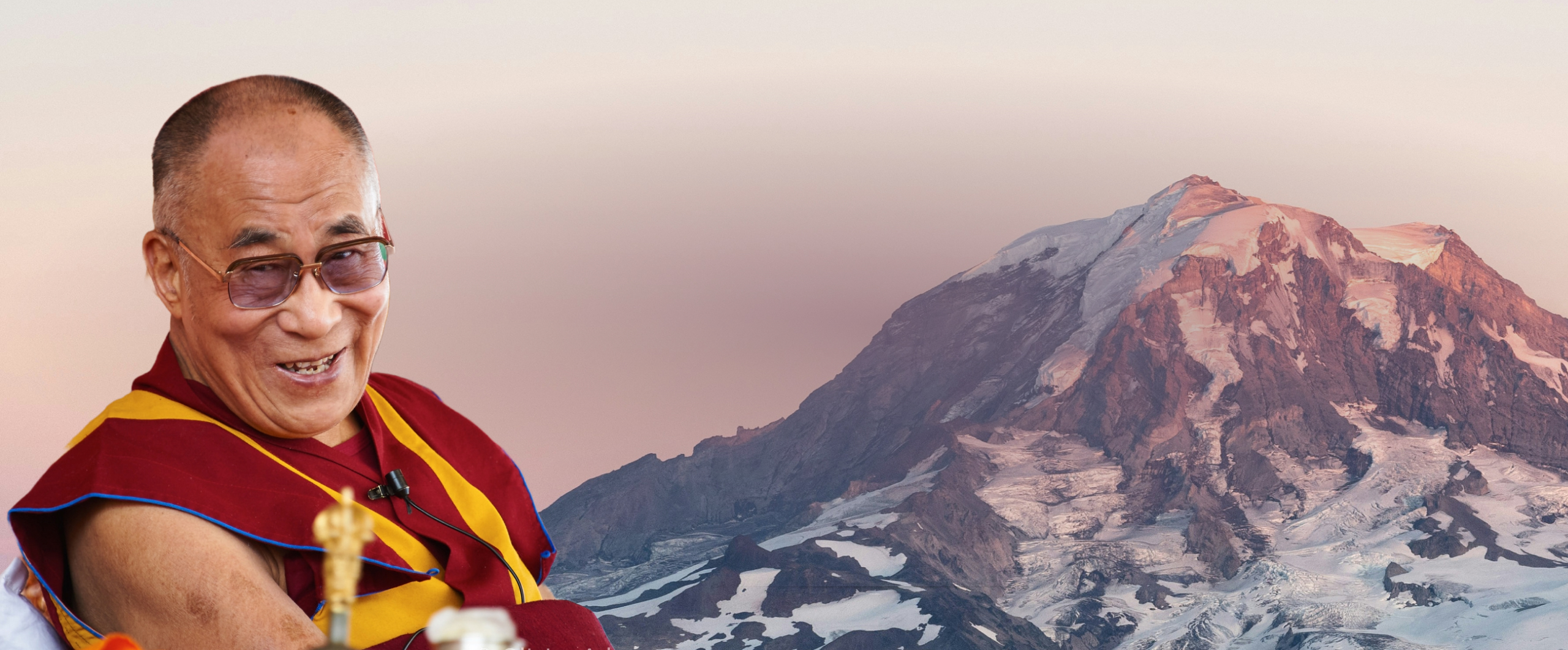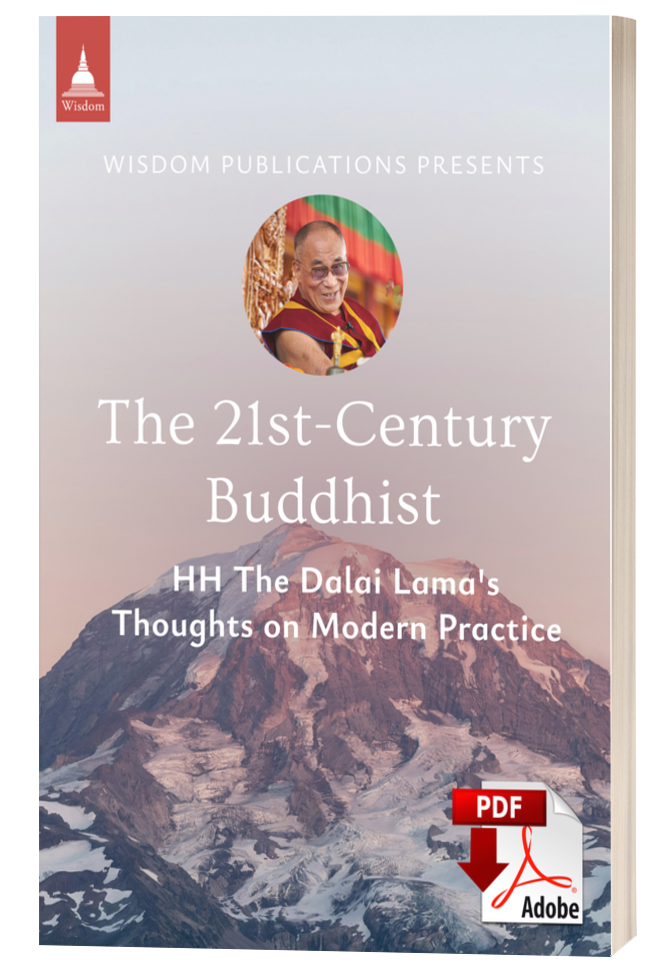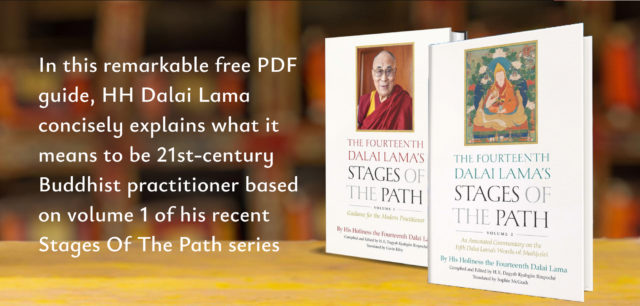
A Complimentary Book from HH Dalai Lama
The 21st-Century Buddhist
His Holiness's Thoughts on Modern Practice
The 21st-Century Buddhist is a concise (18-page) PDF guide from His Holiness The Dalai Lama on how to approach traditional Buddhist practice in the context of the modern world. Access your free download below.
Get Your Free PDF Guide
Read on below to find out more about what you’ll get in your free 21st-Century Buddhist PDF guide. If you want to receive the PDF, simply enter your first name and email address below. You’ll receive the PDF guide within moments and your inbox will not be spammed.
If you don’t see the PDF email in your inbox, kindly check your spam folder.
What’s in the PDF Guide
KEY CONCEPTS EXPLORED
Faith Grounded in Reason
In this section of the guide, His Holiness discusses how to avoid a dogmatic mode of practice, instead generating faith on the basis of wisdom.
Valid Ways of Investigating and Knowing Phenomena
To develop this form of faith and resultant practice, we need to investigate various phenomena by means of empirical evidence, personal experience, and profound reasoning. HH Dalai Lama explains this process in this section.
Where Spiritual Practice Fits Within the Context of the Modern Life
His Holiness provides details on how to integrate resources such as Western philosophy and modern science into your approach to Buddhist faith and practice.
Sound good? Get the PDF guide now!
Know the Source
Content used in this remarkable PDF guide is drawn exclusively from the recent Fourteen Dalai Lama’s Stages of the Path series, in particular the first volume Guidance for the Modern Practitioner.
 Tenzin Gyatso, the Fourteenth Dalai Lama, is the spiritual leader of the Tibetan people. He frequently describes himself as a simple Buddhist monk. Born in northeastern Tibet in 1935, he was as a toddler recognized as the incarnation of the Thirteenth Dalai Lama and brought to Tibet’s capital, Lhasa. He passed his scholastic examinations with honors before fleeing the Chinese forces to India in 1959. There he set up the Tibetan government-in-exile in Dharamsala, working to secure the welfare of the more than 100,000 Tibetan exiles and prevent the destruction of Tibetan culture. In his capacity as a spiritual and political leader, he has traveled to more than sixty-two countries on six continents and met with presidents, popes, and leading scientists to foster dialogue and create a better world. In recognition of his tireless work for the nonviolent liberation of Tibet, the Dalai Lama was awarded the Nobel Peace Prize in 1989. In 2012, he relinquished political authority in his exile government and turned it over to democratically elected representatives. As a superior scholar trained in the classical texts of the Nalanda tradition of Indian Buddhism, he is able to distill the central tenets of Buddhist philosophy in clear and inspiring language, his gift for pedagogy imbued with his infectious joy. Wisdom Publications is proud to be the premier publisher of the Dalai Lama’s more serious and in-depth works.
Tenzin Gyatso, the Fourteenth Dalai Lama, is the spiritual leader of the Tibetan people. He frequently describes himself as a simple Buddhist monk. Born in northeastern Tibet in 1935, he was as a toddler recognized as the incarnation of the Thirteenth Dalai Lama and brought to Tibet’s capital, Lhasa. He passed his scholastic examinations with honors before fleeing the Chinese forces to India in 1959. There he set up the Tibetan government-in-exile in Dharamsala, working to secure the welfare of the more than 100,000 Tibetan exiles and prevent the destruction of Tibetan culture. In his capacity as a spiritual and political leader, he has traveled to more than sixty-two countries on six continents and met with presidents, popes, and leading scientists to foster dialogue and create a better world. In recognition of his tireless work for the nonviolent liberation of Tibet, the Dalai Lama was awarded the Nobel Peace Prize in 1989. In 2012, he relinquished political authority in his exile government and turned it over to democratically elected representatives. As a superior scholar trained in the classical texts of the Nalanda tradition of Indian Buddhism, he is able to distill the central tenets of Buddhist philosophy in clear and inspiring language, his gift for pedagogy imbued with his infectious joy. Wisdom Publications is proud to be the premier publisher of the Dalai Lama’s more serious and in-depth works.
Know the Lineage
Atiśa Dīpaṃkara (982–1054) was a famed scholar and teacher from the Indian monastic university of Vikramalaśīla and wrote Bodhipathapradīpa (A Lamp for the Path to Enlightenment), the book that brought about proliferation of the lamrim teachings in Tibet.
Tsongkhapa Losang Dragpa (1357–1419) was one of the finest scholar-practitioners in Tibetan Buddhism. Renowned for both his written works and his meditative accomplishments, he founded the Gelug school, which produced the lineage of the Dalai Lamas. He famously wrote the lamrim (The Stages of the Path to Enlightenment) in brief, middling, and great forms.
Sonam Gyatso, the Third Dalai Lama (1543–1588), was a famed teacher who studied under the great Panchen Sonam Dragpa (1478–1554) and was instrumental in the spread of the Buddhist teachings from Tibet to Mongolia. He wrote one of the eight great lamrim commentaries entitled Essence of Refined Gold.
Losang Chokyi Gyaltsen, the Fourth Panchen Lama (1570–1662), was one of the most prolific Gelug masters in both sutra and tantra. He wrote the condensed, practice-oriented lamrim text The Easy Path.
Ngawang Losang Gyatso, the Fifth Dalai Lama (1617–1682), was a towering figure in his influence on spheres of both politics and spirituality in Tibet. He wrote extensively on Buddhist philosophy and practice, notably penning the important middling-length lamrim Oral Transmission of Mañjuśrī.
Losang Yeshe, the Fifth Panchen Lama (1663–1737), was preceptor of two Dalai Lamas and also the composer of The Swift Path, a practical and systematic guide to meditating on the lamrim based on The Easy Path, a more concise work by the Fourth Panchen Lama. .
Dakpo Gomchen Ngawang Dragpa (circa 15th c.) was a great scholar and tantric adept having studied the great texts under the preeminent Gelugpa masters of the day, including Gyaltsab Je, Khedrub Je, and Choeje Lodro Tenpa. He wrote the acclaimed lamrim treatise Essence of Fine Speech.


